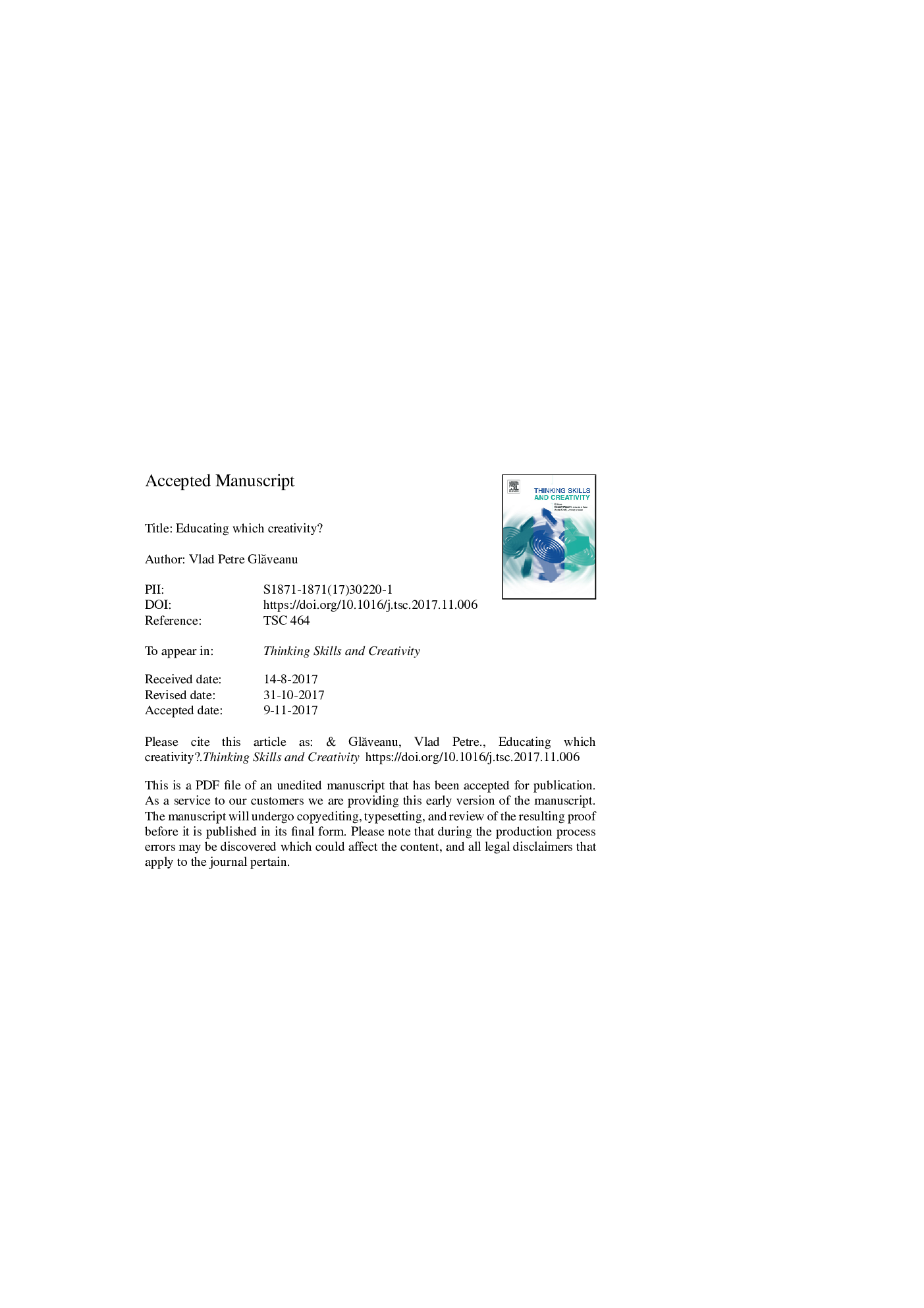| کد مقاله | کد نشریه | سال انتشار | مقاله انگلیسی | نسخه تمام متن |
|---|---|---|---|---|
| 6851837 | 1436832 | 2018 | 22 صفحه PDF | دانلود رایگان |
عنوان انگلیسی مقاله ISI
Educating which creativity?
ترجمه فارسی عنوان
آموزش خلاقیت؟
دانلود مقاله + سفارش ترجمه
دانلود مقاله ISI انگلیسی
رایگان برای ایرانیان
کلمات کلیدی
خلاقیت، فرهنگ، جامعه، ارزیابی، آموزش خلاقیت،
ترجمه چکیده
این مقاله به بررسی ساخت و ساز اجتماعی فرهنگی خلاقیت می پردازد و نشان می دهد که در مورد چگونگی شناخت و آموزش پتانسیل خلاقانه، آن را بیان می کند. بر پایه تحلیل تاریخی خلاقیت و مفاهیم مرتبط، مانند نابغه و استعداد، از دوران باستان، من سه روش نمونه اولیه برای تعریف خلاقیت را شناسایی می کنم. اولین و رایج ترین آن، ادامه میراث رنسانس و رمانتیسیسم، خلاقیت را با هنر مرتبط می کند و بر بیان خود، اصالت و تفکر واگرا تأکید می کند. دومین، مربوط به آرمان های روشنگری، خلاقیت را با علم و کشف متصل می کند و جنبه های کاربردی و حل مسئله را به جلو می برد. آخرین باری نیست که بعد از مدرنیته استعاره های جدیدی را برای خلاقیت پیشرفت می کند و ما را مجبور می کند پویایی زندگی روزمره خود را دوباره درک کنیم. یکی از آنها از صنعتگران است، آماده ترکیب و مطابقت، برای آزمایش و تفکر در مورد نقش سنت و عادت در خلاقیت. هر یک از این موقعیتهای پارادایمی - هنرمند، مخترع و صنعتگران - روابط متقابل بین خلاقیت و جامعه را پیشنهاد می کنند و پیامدهای عمیقی را برای خلاقیت در آموزش و پرورش و فراتر از آن پیدا می کنند.
موضوعات مرتبط
علوم انسانی و اجتماعی
روانشناسی
روانشناسی رشد و آموزشی
چکیده انگلیسی
This paper explores the sociocultural construction of creativity and reflects on its implications for how we understand and educate creative potential. Drawing on a historical analysis of creativity and related concepts, such as genius and talent, from Antiquity onwards, I identify three prototypical ways of defining creativity. The first and most common one, continuing the legacy of the Renaissance and Romanticism, associates creativity with the arts and emphasizes self-expression, originality, and divergent thinking. The second one, related to the ideals of the Enlightenment, connects creativity with science and discovery and brings to the fore its functional, problem solving aspects. Last but not least, post-modernity advances new metaphors for creativity and invites us to rethink its everyday life dynamic. One of them is that of the craftsmen, ready to mix and match, to experiment and reflect on the role of tradition and habit in creativity. Each one of these paradigmatic positions - the artist, the inventor, and the craftsmen - propose different relations between creativity and society and have deep implications for how we discover and cultivate creativity in education and beyond.
ناشر
Database: Elsevier - ScienceDirect (ساینس دایرکت)
Journal: Thinking Skills and Creativity - Volume 27, March 2018, Pages 25-32
Journal: Thinking Skills and Creativity - Volume 27, March 2018, Pages 25-32
نویسندگان
Vlad Petre GlÄveanu,
